Biermann Ch. Handbook of Pulping and Papermaking
Подождите немного. Документ загружается.

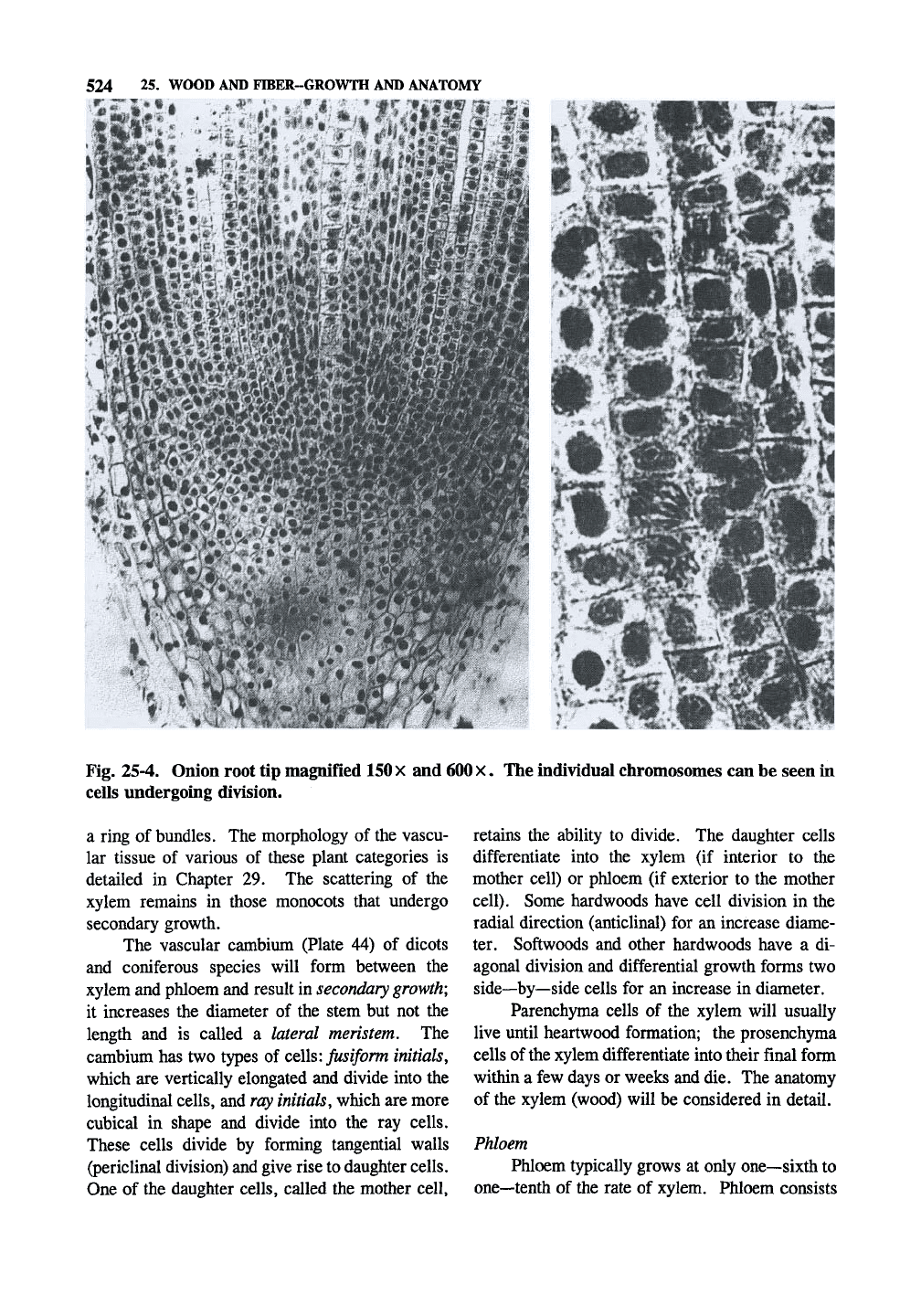
524 25. WOOD AND FTOER-GROWTH AND ANATOMY
Fig. 25-4. Onion root tip magnified
150
x and
600
x. The individual chromosomes can be seen in
cells undergoing division.
a ring of bundles. The morphology of the vascu-
lar tissue of various of these plant categories is
detailed in Chapter 29. The scattering of the
xylem remains in those monocots that undergo
secondary growth.
The vascular cambium (Plate 44) of dicots
and coniferous species will form between the
xylem and phloem and result in
secondary
growth;
it increases the diameter of the stem but not the
length and is called a lateral meristem. The
cambium has two types of
cells:
fusiform initials,
which are vertically elongated and divide into the
longitudinal cells, and ray initials, which are more
cubical in shape and divide into the ray cells.
These cells divide by forming tangential walls
(periclinal division) and give rise to daughter cells.
One of the daughter cells, called the mother cell,
retains the ability to divide. The daughter cells
differentiate into the xylem (if interior to the
mother cell) or phloem (if exterior to the mother
cell).
Some hardwoods have cell division in the
radial direction (anticlinal) for an increase diame-
ter. Softwoods and other hardwoods have a di-
agonal division and differential growth forms two
side—by—side cells for an increase in diameter.
Parenchyma cells of the xylem will usually
live until heartwood formation; the prosenchyma
cells of the xylem differentiate into their final form
within a few days or weeks and die. The anatomy
of the xylem (wood) will be considered in detail.
Phloem
Phloem typically grows at only one—sixth to
one—tenth of the rate of xylem. Phloem consists
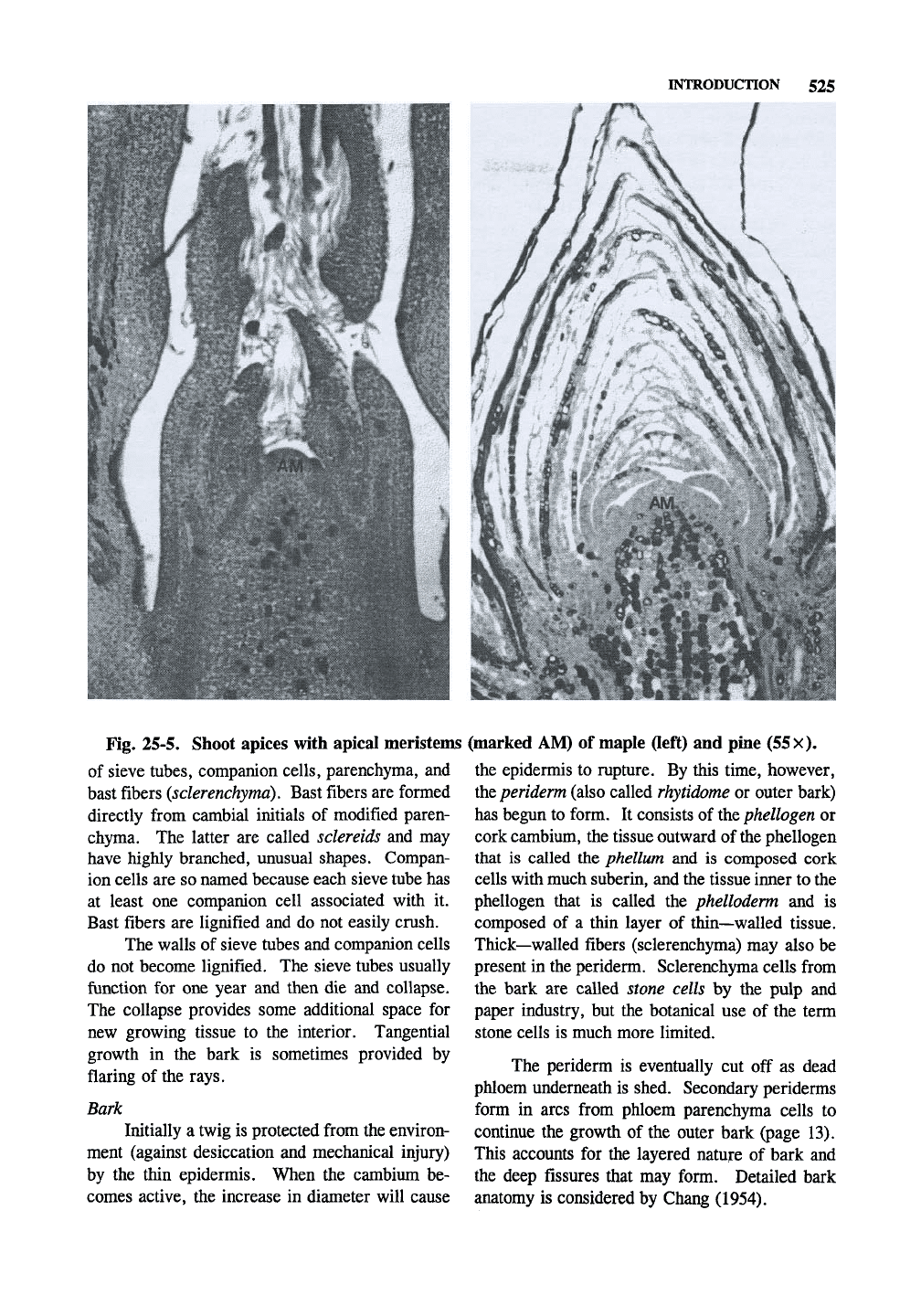
INTRODUCTION 525
Fig. 25-5. Shoot apices with apical meristems
of sieve tubes, companion cells, parenchyma, and
bast fibers (sclerenchyma). Bast fibers are formed
directly from cambial initials of modified paren-
chyma. The latter are called sclereids and may
have highly branched, unusual shapes. Compan-
ion cells are so named because each sieve tube has
at least one companion cell associated with it.
Bast fibers are lignified and do not easily crush.
The walls of sieve tubes and companion cells
do not become lignified. The sieve tubes usually
function for one year and then die and collapse.
The collapse provides some additional space for
new growing tissue to the interior. Tangential
growth in the bark is sometimes provided by
flaring of the rays.
Bark
Initially a twig is protected from the environ-
ment (against desiccation and mechanical injury)
by the thin epidermis. When the cambium be-
comes active, the increase in diameter will cause
(marked AM) of maple Oeft) and pine (SSx).
the epidermis to rupture. By this time, however,
the periderm (also called rhytidome or outer bark)
has begun to form. It consists of the phellogen or
cork cambium, the tissue outward of
the
phellogen
that is called the phellum and is composed cork
cells with much suberin, and the tissue inner to the
phellogen that is called the phelloderm and is
composed of a thin layer of thin—walled tissue.
Thick—walled fibers (sclerenchyma) may also be
present in the periderm. Sclerenchyma cells from
the bark are called stone cells by the pulp and
paper industry, but the botanical use of the term
stone cells is much more limited.
The periderm is eventually cut off as dead
phloem underneath is shed. Secondary periderms
form in arcs from phloem parenchyma cells to
continue the growth of the outer bark (page 13).
This accounts for the layered nature of bark and
the deep fissures that may form. Detailed bark
anatomy is considered by Chang (1954).
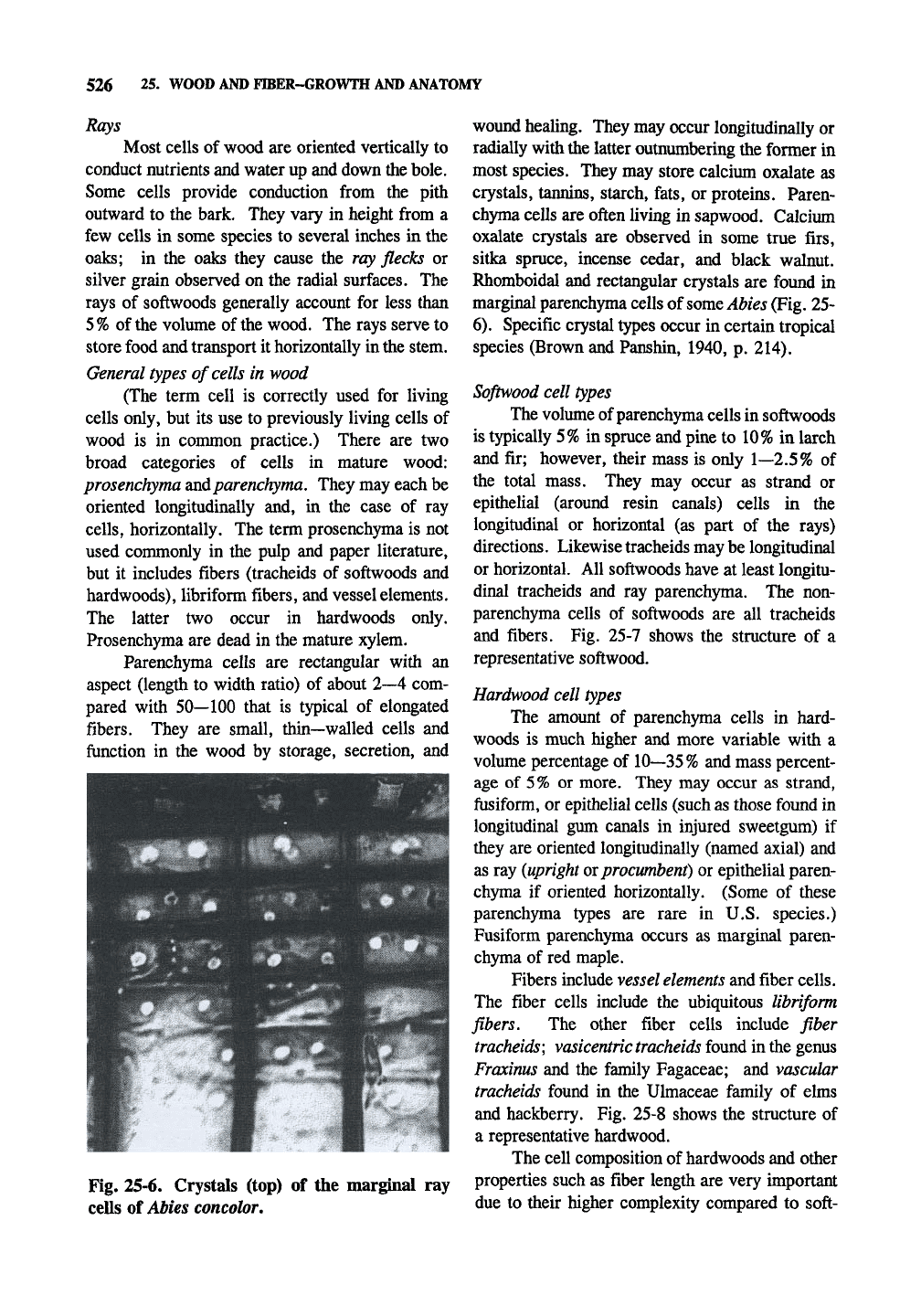
526 25. WOOD AND FIBER-GROWTH AND ANATOMY
Rays
Most cells of wood are oriented vertically to
conduct nutrients and water up and down the bole.
Some cells provide conduction from the pith
outward to the bark. They vary in height from a
few cells in some species to several inches in the
oaks;
in the oaks they cause the ray flecks or
silver grain observed on the radial surfaces. The
rays of softwoods generally account for less than
5 %
of the volume of the wood. The rays serve to
store food and transport it horizontally in
the
stem.
General types of
cells
in wood
(The term cell is correctly used for living
cells only, but its use to previously living cells of
wood is in common practice.) There are two
broad categories of cells in mature wood:
prosenchyma and parenchyma. They may each be
oriented longitudinally and, in the case of ray
cells,
horizontally. The term prosenchyma is not
used commonly in the pulp and paper literature,
but it includes fibers (tracheids of softwoods and
hardwoods), libriform fibers, and vessel elements.
The latter two occur in hardwoods only.
Prosenchyma are dead in the mature xylem.
Parenchyma cells are rectangular with an
aspect (length to width ratio) of about 2—4 com-
pared with 50—100 that is typical of elongated
fibers. They are small, thin—walled cells and
ftmction in the wood by storage, secretion, and
Fig. 25-6. Crystals (top) of the marginal ray
cells of Abies concolor.
wound healing. They may occur longitudinally or
radially with the latter outnumbering the former in
most species. They may store calcium oxalate as
crystals, tannins, starch, fats, or proteins. Paren-
chyma cells are often living in sapwood. Calcium
oxalate crystals are observed in some true firs,
sitka spruce, incense cedar, and black walnut.
Rhomboidal and rectangular crystals are found m
marginal parenchyma cells of
some
Abies (Fig. 25-
6).
Specific crystal types occur in certain tropical
species (Brown and Panshin, 1940, p. 214).
Softwood cell types
The volume of parenchyma cells in softwoods
is typically 5% in spruce and pine to 10% in larch
and fir; however, their mass is only
1—2.5%
of
the total mass. They may occur as strand or
epithelial (around resin canals) cells in the
longitudinal or horizontal (as part of the rays)
directions. Likewise tracheids may be longitudinal
or horizontal. All softwoods have at least longitu-
dinal tracheids and ray parenchyma. The non-
parenchyma cells of softwoods are all tracheids
and fibers. Fig. 25-7 shows the structure of a
representative softwood.
Hardwood cell types
The amount of parenchyma cells in hard-
woods is much higher and more variable with a
volume percentage of 10—35% and mass percent-
age of 5% or more. They may occur as strand,
fusiform, or epithelial cells (such as those found in
longitudinal gum canals in injured sweetgum) if
they are oriented longitudinally (named axial) and
as ray
{upright
ox procumbent) or epithelial paren-
chyma if oriented horizontally. (Some of these
parenchyma types are rare in U.S. species.)
Fusiform parenchyma occurs as marginal paren-
chyma of red maple.
Fibers include
vessel elements
and fiber cells.
The fiber cells include the ubiquitous libriform
fibers. The other fiber cells include fiber
tracheids;
vasicentric tracheids
found in the genus
Fraxinus and the family Fagaceae; and vascular
tracheids found in the Ulmaceae family of elms
and hackberry. Fig. 25-8 shows the structure of
a representative hardwood.
The cell composition of hardwoods and other
properties such as fiber length are very important
due to their higher complexity compared to soft-
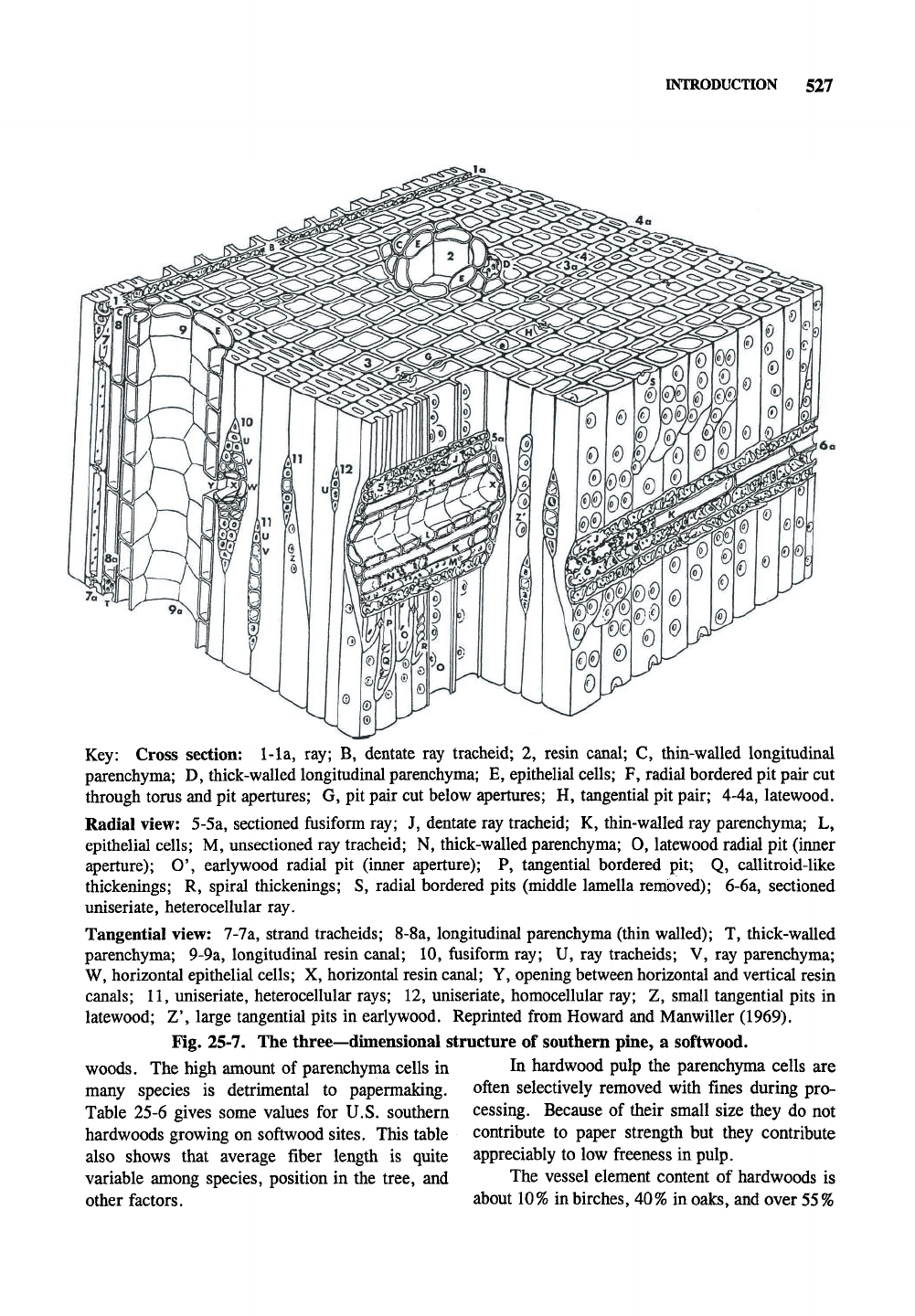
INTRODUCTION
527
Key: Cross section: 1-la, ray; B, dentate ray tracheid; 2, resin canal; C, thin-walled longitudinal
parenchyma; D, thick-walled longitudinal parenchyma; E, epithelial cells; F, radial bordered pit pair cut
through torus and pit apertures; G, pit pair cut below apertures; H, tangential pit pair; 4-4a, latewood.
Radial view: 5-5a, sectioned fusiform ray; J, dentate ray tracheid; K, thin-walled ray parenchyma; L,
epithelial cells; M, unsectioned ray tracheid; N, thick-walled parenchyma; 0, latewood radial pit (inner
aperture); 0\ earlywood radial pit (inner aperture); P, tangential bordered pit; Q, callitroid-like
thickenings; R, spiral thickenings; S, radial bordered pits (middle lamella removed); 6-6a, sectioned
uniseriate, heterocellular ray.
Tangential view: 7-7a, strand tracheids; 8-8a, longitudinal parenchyma (thin walled); T, thick-walled
parenchyma; 9-9a, longitudinal resin canal; 10, fusiform ray; U, ray tracheids; V, ray parenchyma;
W, horizontal epithelial cells; X, horizontal resin canal; Y, opening between horizontal and vertical resin
canals; 11, uniseriate, heterocellular rays; 12, uniseriate, homocellular ray; Z, small tangential pits in
latewood; Z', large tangential pits in earlywood. Reprinted from Howard and Manwiller (1969).
Fig. 25-7. The three—dimensional structure of southern pine, a softwood.
woods. The high amount of parenchyma cells in In hardwood pulp the parenchyma cells are
many species is detrimental to papermaking. often selectively removed with fines during pro-
Table 25-6 gives some values for U.S. southern
hardwoods growing on softwood sites. This table
also shows that average fiber length is quite
variable among species, position in the tree, and
other factors.
cessing. Because of their small size they do not
contribute to paper strength but they contribute
appreciably to low freeness in pulp.
The vessel element content of hardwoods is
about 10% in birches, 40% in oaks, and over 55%
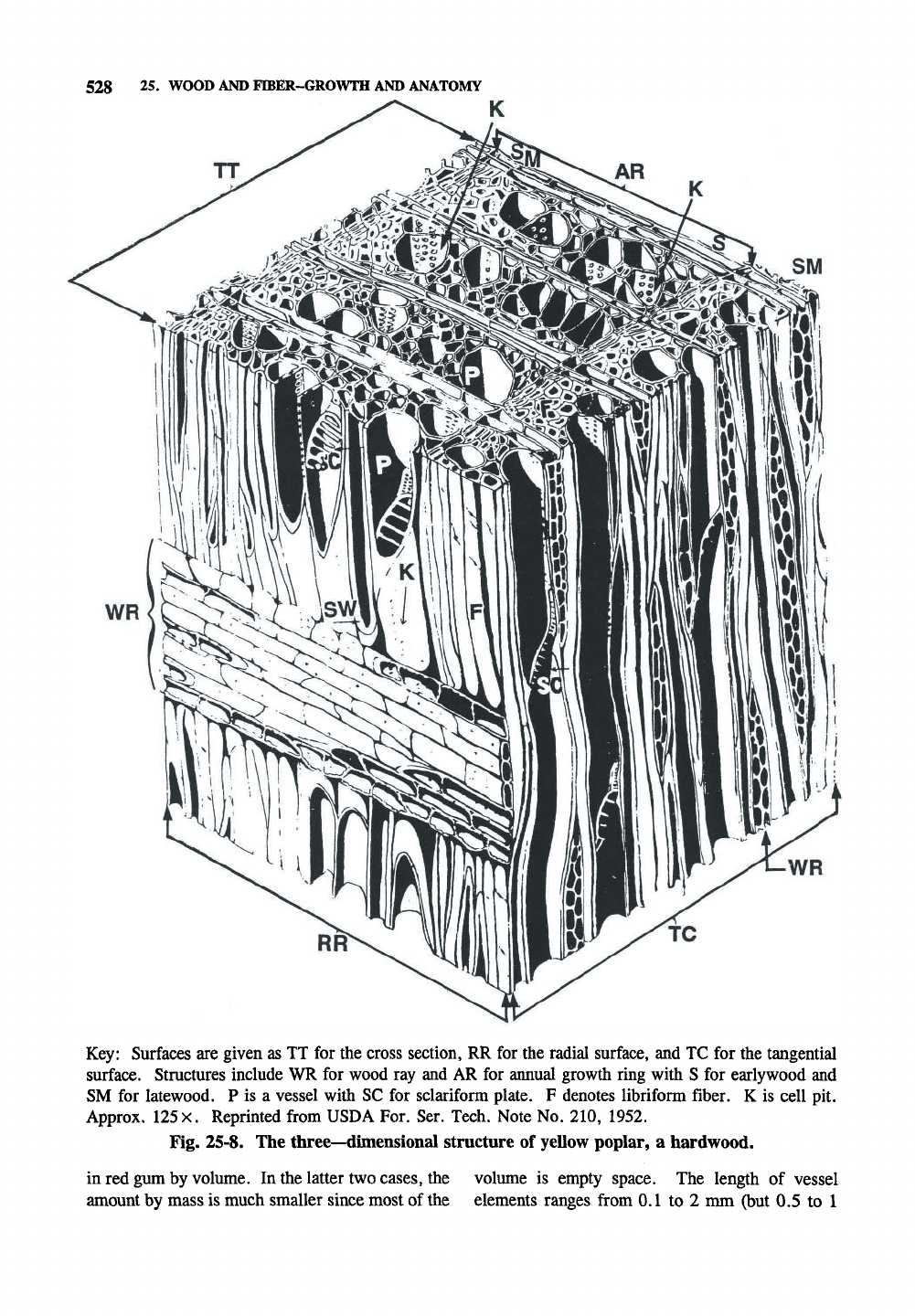
528 25. WOOD AND FIBER-GROWTH AND ANATOMY
Key: Surfaces are given as TT for the cross section, RR for the radial surface, and TC for the tangential
surface. Structures include WR for wood ray and AR for annual growth ring with S for earlywood and
SM for latewood. P is a vessel with SC for sclariform plate. F denotes libriform fiber. K is cell pit.
Approx.
125
X.
Reprinted from USDA For. Ser. Tech. Note No. 210, 1952.
Fig. 25-8. The three—dimensional structure of yellow poplar, a hardwood.
in red gum by volume. In the latter two cases, the volume is empty space. The length of vessel
amount by mass is much smaller since most of the elements ranges from 0.1 to 2 mm (but 0.5 to 1
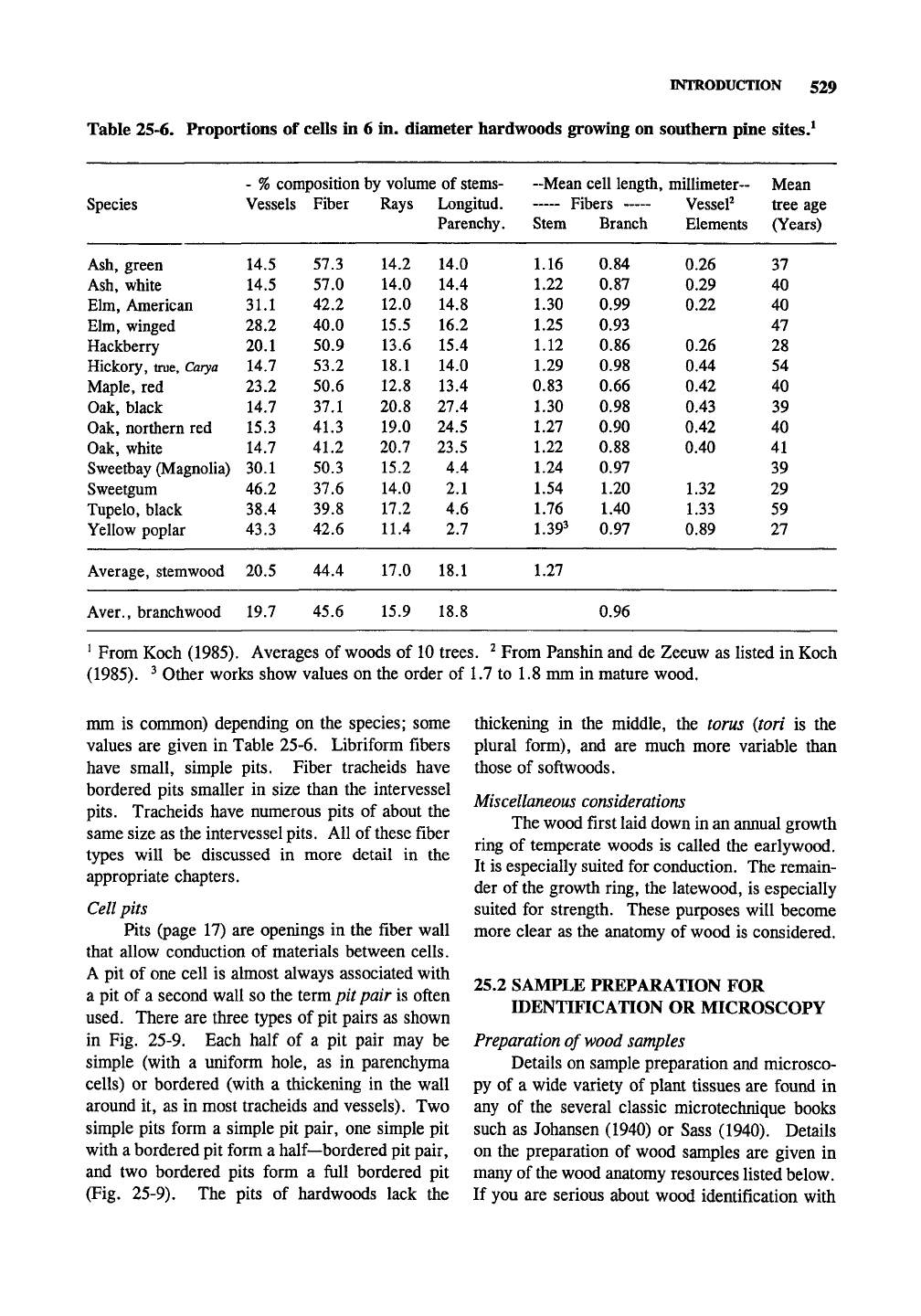
INTRODUCTION 529
Table 25-6. Proportions of cells in 6 in. diameter hardwoods growing on southern pine sites.^
Species
Ash, green
Ash, white
Elm, American
Elm, winged
Hackberry
Hickory, true, Carya
Maple, red
Oak, black
Oak, northern red
Oak, white
Sweetbay (Magnolia)
Sweetgum
Tupelo, black
Yellow poplar
Average, stem wood
Aver., branch wood
-
%
composition by volume of stems-
Vessels
14.5
14.5
31.1
28.2
20.1
14.7
23.2
14.7
15.3
14.7
30.1
46.2
38.4
43.3
20.5
19.7
Fiber
57.3
57.0
42.2
40.0
50.9
53.2
50.6
37.1
41.3
41.2
50.3
37.6
39.8
42.6
44.4
45.6
Rays
14.2
14.0
12.0
15.5
13.6
18.1
12.8
20.8
19.0
20.7
15.2
14.0
17.2
11.4
17.0
15.9
Longitud.
Parenchy.
14.0
14.4
14.8
16.2
15.4
14.0
13.4
27.4
24.5
23.5
4.4
2.1
4.6
2.7
18.1
18.8
-Mean cell length.
Fibers
Stem
1.16
1.22
1.30
1.25
1.12
1.29
0.83
1.30
1.27
1.22
1.24
1.54
1.76
1.39^
1.27
Branch
0.84
0.87
0.99
0.93
0.86
0.98
0.66
0.98
0.90
0.88
0.97
1.20
1.40
0.97
0.96
millimeter-
Vessel^
Elements
0.26
0.29
0.22
0.26
0.44
0.42
0.43
0.42
0.40
1.32
1.33
0.89
Mean
tree age
(Years)
37
40
40
47
28
54
40
39
40
41
39
29
59
27
^
From Koch (1985). Averages of woods of 10 trees.
^
From Panshin and de Zeeuw as listed in Koch
(1985).
^
Other works show values on the order of 1.7 to 1.8 mm in mature wood.
nun is common) depending on the species; some
values are given in Table 25-6. Libriform fibers
have small, simple pits. Fiber tracheids have
bordered pits smaller in size than the intervessel
pits.
Tracheids have numerous pits of about the
same size as the intervessel
pits.
All of these fiber
types will be discussed in more detail in the
appropriate chapters.
Cell
pits
Pits (page 17) are openings in the fiber wall
that allow conduction of materials between cells.
A pit of one cell is almost always associated with
a pit of a second wall so the term pit pair is often
used. There are three types of pit pairs as shown
in Fig. 25-9. Each half of a pit pair may be
simple (with a uniform hole, as in parenchyma
cells) or bordered (with a thickening in the wall
around it, as in most tracheids and vessels). Two
simple pits form a simple pit pair, one simple pit
with a bordered pit form a half—bordered pit pair,
and two bordered pits form a full bordered pit
(Fig. 25-9). The pits of hardwoods lack the
thickening in the middle, the torus (tori is the
plural form), and are much more variable than
those of softwoods.
Miscellaneous considerations
The wood first laid down in an annual growth
ring of temperate woods is called the earlywood.
It is especially suited for conduction. The remain-
der of the growth ring, the latewood, is especially
suited for strength. These purposes will become
more clear as the anatomy of wood is considered.
25.2 SAMPLE PREPARATION FOR
IDENTIFICATION OR MICROSCOPY
Preparation
of
wood
samples
Details on sample preparation and microsco-
py of a wide variety of plant tissues are found in
any of the several classic microtechnique books
such as Johansen (1940) or Sass (1940). Details
on the preparation of wood samples are given in
many of
the
wood anatomy resources listed below.
If you are serious about wood identification with
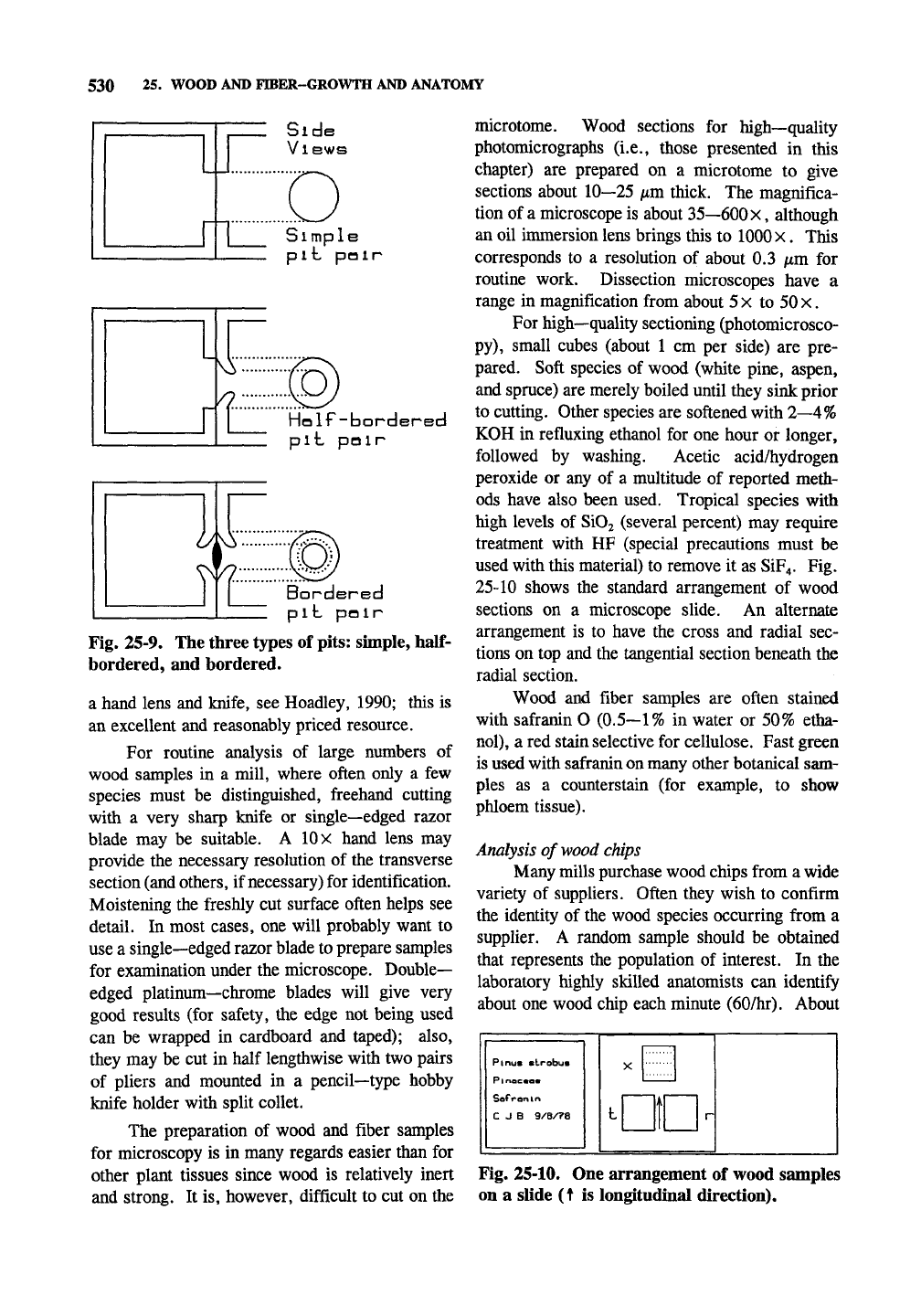
530
25. WOOD AND FIBER-GROWTH AND ANATOMY
Side
Views
Simple
pit pair
HQIF-bordered
pit pair
Bordered
pit polr
Fig. 25-9. The three types of
pits:
simple,
half-
bordered, and bordered.
a hand lens and knife, see Hoadley, 1990; this is
an excellent and reasonably priced resource.
For routine analysis of large numbers of
wood samples in a mill, where often only a few
species must be distinguished, freehand cutting
with a very sharp knife or single—edged razor
blade may be suitable. A lOx hand lens may
provide the necessary resolution of the transverse
section (and others, if necessary) for identification.
Moistening the freshly cut surface often helps see
detail. In most cases, one will probably want to
use a single—edged razor blade to prepare samples
for examination under the microscope. Double-
edged platinum—chrome blades will give very
good results (for safety, the edge not being used
can be wrapped in cardboard and taped); also,
they may be cut in half lengthwise with two pairs
of pliers and mounted in a pencil—type hobby
knife holder with split collet.
The preparation of wood and fiber samples
for microscopy is in many regards easier than for
other plant tissues since wood is relatively inert
and strong. It is, however, difficult to cut on the
microtome. Wood sections for high—quality
photomicrographs (i.e., those presented in this
chapter) are prepared on a microtome to give
sections about 10—25 fim thick. The magnifica-
tion of a microscope is about
35—600
x, although
an oil immersion lens brings this to
1000
x. This
corresponds to a resolution of about 0.3 /xm for
routine work. Dissection microscopes have a
range in magnification from about
5
x to
50
x.
For high—quality sectioning (photomicrosco-
py),
small cubes (about 1 cm per side) are pre-
pared. Soft species of wood (white pine, aspen,
and spruce) are merely boiled until they sink prior
to cutting. Other species are softened with 2—4%
KOH in refluxing ethanol for one hour or longer,
followed by washing. Acetic acid/hydrogen
peroxide or any of a multitude of reported meth-
ods have also been used. Tropical species with
high levels of SiOj (several percent) may require
treatment with HF (special precautions must be
used with this material) to remove it as SiF4. Fig.
25-10 shows the standard arrangement of wood
sections on a microscope slide. An alternate
arrangement is to have the cross and radial sec-
tions on top and the tangential section beneath the
radial section.
Wood and fiber samples are often stained
with safranin O
(0.5—1%
in water or 50% etha-
nol),
a red stain selective for cellulose. Fast green
is used with safranin on many other botanical sam-
ples as a counter stain (for example, to show
phloem tissue).
Analysis of
wood
chips
Many mills purchase wood chips from a wide
variety of suppliers. Often they wish to confirm
the identity of the wood species occurring from a
supplier. A random sample should be obtained
that represents the population of interest. In the
laboratory highly skilled anatomists can identify
about one wood chip each minute (60/hr). About
1
Plnus strobuB 1
1
P1nac*a« 1
11
Sofronln 1
C
J B
9/8/78
1
x^
OP-
Fig. 25-10. One arrangement of wood samples
on a slide (t is longitudinal direction).
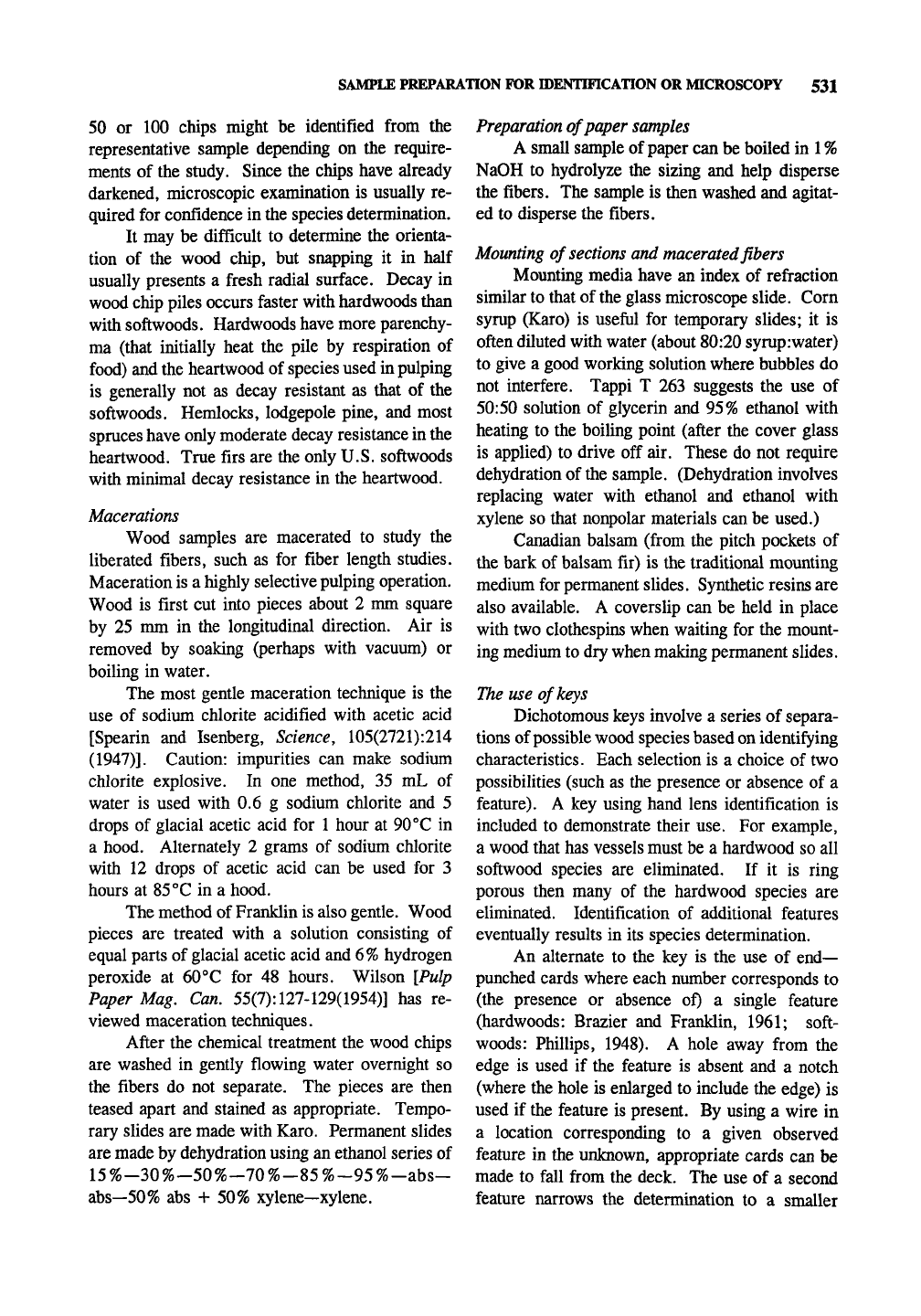
SAMPLE PREPARATION FOR IDENTIFICATION OR MICROSCOPY 531
50 or 100 chips might be identified from the
representative sample depending on the require-
ments of the study. Since the chips have already
darkened, microscopic examination is usually re-
quired for confidence in
the
species determination.
It may be difficult to determine the orienta-
tion of the wood chip, but snapping it in half
usually presents a fresh radial surface. Decay in
wood chip piles occurs faster with hardwoods than
with softwoods. Hardwoods have more parenchy-
ma (that initially heat the pile by respiration of
food) and the heartwood of species used
in
pulping
is generally not as decay resistant as that of the
softwoods. Hemlocks, lodgepole pine, and most
spruces have only moderate decay resistance
in
the
heartwood. True firs are the only U.S. softwoods
with minimal decay resistance in the heartwood.
Macerations
Wood samples are macerated to study the
liberated fibers, such as for fiber length studies.
Maceration is a highly selective pulping operation.
Wood is first cut into pieces about 2 mm square
by 25 mm in the longitudinal direction. Air is
removed by soaking (perhaps with vacuum) or
boiling in water.
The most gentle maceration technique is the
use of sodium chlorite acidified with acetic acid
[Spearin and Isenberg, Science, 105(2721):214
(1947)].
Caution: impurities can make sodium
chlorite explosive. In one method, 35 mL of
water is used with 0.6 g sodium chlorite and 5
drops of glacial acetic acid for 1 hour at 90°C in
a hood. Alternately 2 grams of sodium chlorite
with 12 drops of acetic acid can be used for 3
hours at 85 °C in a hood.
The method of
Franklin
is also gentle. Wood
pieces are treated with a solution consisting of
equal parts of glacial acetic acid and
6%
hydrogen
peroxide at 60°C for 48 hours. Wilson {Pulp
Paper Mag, Can.
55(7):
127-129(1954)]
has re-
viewed maceration techniques.
After the chemical treatment the wood chips
are washed in gently flowing water overnight so
the fibers do not separate. The pieces are then
teased apart and stained as appropriate. Tempo-
rary slides are made with Karo. Permanent slides
are made by dehydration using
an
ethanol series of
15%-30%-50%-70%-85%-95%-abs-
abs—50%
abs + 50% xylene—xylene.
Preparation
of paper samples
A small sample of
paper
can be boiled in
1 %
NaOH to hydrolyze the sizing and help disperse
the fibers. The sample is then washed and agitat-
ed to disperse the fibers.
Mounting
of sections and macerated fibers
Mounting media have an index of refraction
similar to that of
the
glass microscope slide. Corn
syrup (Karo) is usefiil for temporary slides; it is
often diluted with water (about 80:20 syrup:water)
to give a good working solution where bubbles do
not interfere. Tappi T 263 suggests the use of
50:50 solution of glycerin and 95% ethanol with
heating to the boiling point (after the cover glass
is applied) to drive off air. These do not require
dehydration of
the
sample. (Dehydration involves
replacing water with ethanol and ethanol with
xylene so that nonpolar materials can be used.)
Canadian balsam (from the pitch pockets of
the bark of balsam fir) is the traditional mounting
medium for permanent slides. Synthetic resins are
also available. A coverslip can be held in place
with two clothespins when waiting for the mount-
ing medium to dry when making permanent slides.
The
use of keys
Dichotomous keys involve a series of separa-
tions of possible wood species based
on
identifying
characteristics. Each selection is a choice of two
possibilities (such as the presence or absence of a
feature). A key using hand lens identification is
included to demonstrate their use. For example,
a wood that has vessels must be a hardwood so all
softwood species are eliminated. If it is ring
porous then many of the hardwood species are
eliminated. Identification of additional features
eventually results in its species determination.
An alternate to the key is the use of end-
punched cards where each number corresponds to
(the presence or absence of) a single feature
(hardwoods: Brazier and Franklin, 1961; soft-
woods: Phillips, 1948). A hole away from the
edge is used if the feature is absent and a notch
(where the hole is enlarged to include the edge) is
used if the feature is present. By using a wire in
a location corresponding to a given observed
feature in the unknown, appropriate cards can be
made to fall from the deck. The use of a second
feature narrows the determination to a smaller
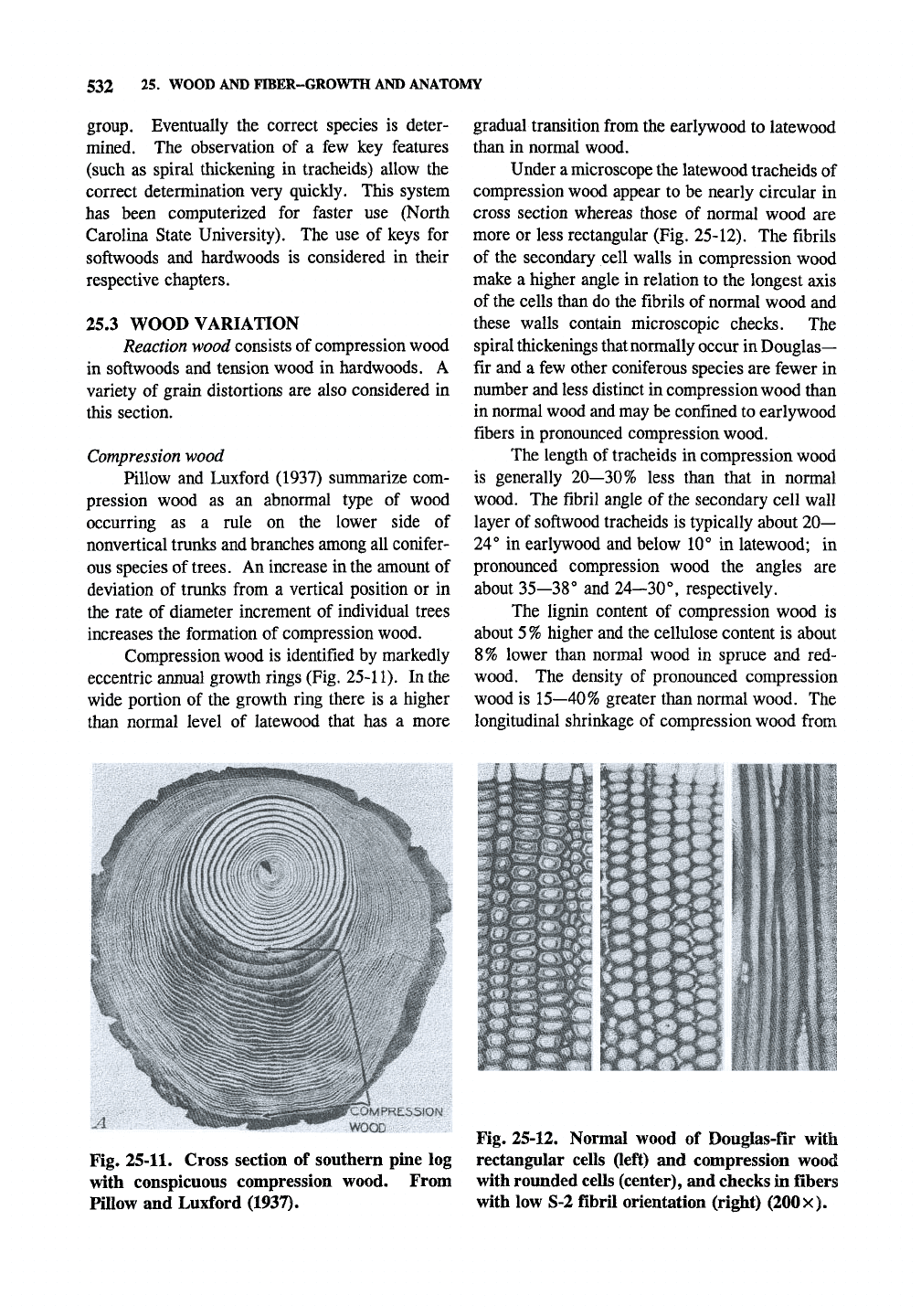
532 25. WOOD AND FffiER-GROWTH AND ANATOMY
group. Eventually the correct species is deter-
mined. The observation of a few key features
(such as spiral thickening in tracheids) allow the
correct determination very quickly. This system
has been computerized for faster use (North
Carolina State University). The use of keys for
softwoods and hardwoods is considered in their
respective chapters.
25.3 WOOD VARIATION
Reaction wood consists of compression wood
in softwoods and tension wood in hardwoods. A
variety of grain distortions are also considered in
this section.
Compression
wood
Pillow and Luxford (1937) summarize com-
pression wood as an abnormal type of wood
occurring as a rule on the lower side of
nonvertical trunks and branches among all conifer-
ous species of
trees.
An increase in the amount of
deviation of trunks from a vertical position or in
the rate of diameter increment of individual trees
increases the formation of compression wood.
Compression wood is identified by markedly
eccentric annual growth rings (Fig. 25-11). In the
wide portion of the growth ring there is a higher
than normal level of latewood that has a more
gradual transition from the earlywood to latewood
than in normal wood.
Under
a
microscope the latewood tracheids of
compression wood appear to be nearly circular in
cross section whereas those of normal wood are
more or less rectangular (Fig. 25-12). The fibrils
of the secondary cell walls in compression wood
make a higher angle in relation to the longest axis
of the cells than do the fibrils of normal wood and
these walls contain microscopic checks. The
spiral thickenings that normally occur in Douglas—
fir and a few other coniferous species are fewer in
number and less distinct in compression wood than
in normal wood and may be confined to earlywood
fibers in pronounced compression wood.
The length of tracheids in compression wood
is generally 20—30% less than that in normal
wood. The fibril angle of the secondary cell wall
layer of softwood tracheids is typically about 20—
24° in earlywood and below 10° in latewood; in
pronounced compression wood the angles are
about 35—38° and 24—30°, respectively.
The lignin content of compression wood is
about 5% higher and the cellulose content is about
8% lower than normal wood in spruce and red-
wood. The density of pronounced compression
wood is 15—40% greater than normal wood. The
longitudinal shrinkage of compression wood from
Fig.
25-11.
Cross section of southern pine log
with conspicuous compression wood. From
PiUow and Luxford (1937).
Fig. 25-12. Normal wood of Douglas-fir with
rectangular cells (left) and compression wood
with rounded cells (center), and checks in fibers
with low S-2 fibril orientation (right) (200x).
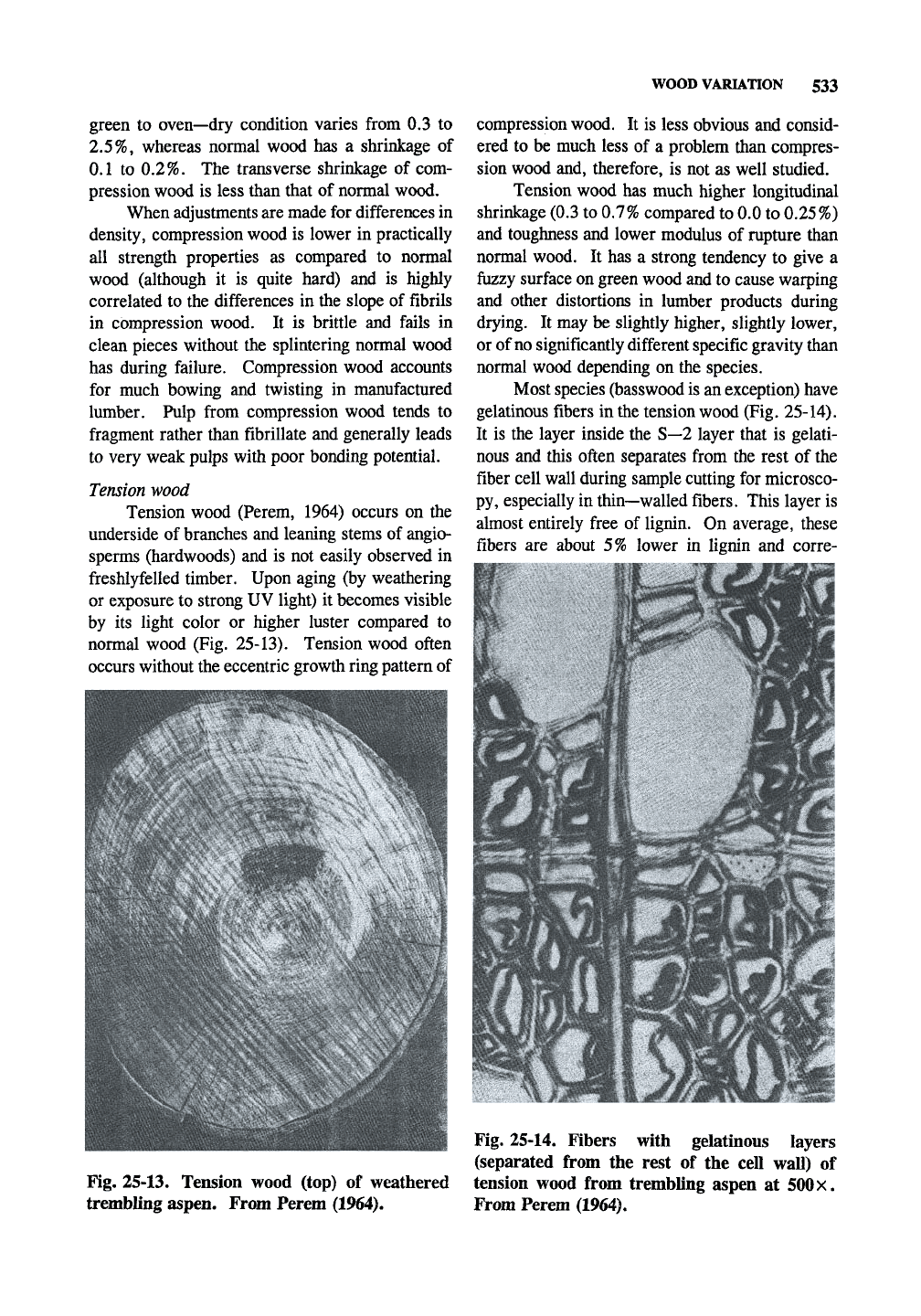
WOOD VARIATION 533
green to oven—dry condition varies from 0.3 to
2.5%,
whereas normal wood has a shrinkage of
0.1 to 0.2%. The transverse shrinkage of com-
pression wood is less than that of normal wood.
When adjustments are made for differences in
density, compression wood is lower in practically
all strength properties as compared to normal
wood (although it is quite hard) and is highly
correlated to the differences in the slope of fibrils
in compression wood. It is brittle and fails in
clean pieces without the splintering normal wood
has during failure. Compression wood accounts
for much bowing and twisting in manufactured
lumber. Pulp from compression wood tends to
fragment rather than fibrillate and generally leads
to very weak pulps with poor bonding potential.
Tension wood
Tension wood (Perem, 1964) occurs on the
underside of branches and leaning stems of angio-
sperms (hardwoods) and is not easily observed in
freshlyfelled timber. Upon aging (by weathering
or exposure to strong UV light) it becomes visible
by its light color or higher luster compared to
normal wood (Fig. 25-13). Tension wood often
occurs without the eccentric growth ring pattern of
compression wood. It is less obvious and consid-
ered to be much less of a problem than compres-
sion wood and, therefore, is not as well studied.
Tension wood has much higher longitudinal
shrinkage (0.3 to 0.7% compared to 0.0 to 0.25%)
and toughness and lower modulus of rupture than
normal wood. It has a strong tendency to give a
fuzzy surface on green wood and to cause warping
and other distortions in lumber products during
drying. It may be slightly higher, slightly lower,
or of no significantly different specific gravity than
normal wood depending on the species.
Most species (basswood is an exception) have
gelatinous fibers in the tension wood (Fig. 25-14).
It is the layer inside the S—2 layer that is gelati-
nous and this often separates from the rest of the
fiber cell wall during sample cutting for microsco-
py, especially in thin—walled fibers. This layer is
almost entirely free of lignin. On average, these
fibers are about 5% lower in lignin and corre-
Fig. 25-13. Tension wood (top) of weathered
trembling aspen. From Perem (1964).
Fig. 25-14. Fibers with gelatinous layers
(separated from the rest of the cell wall) of
tension wood from trembling aspen at
500
x.
From Perem (1964).
